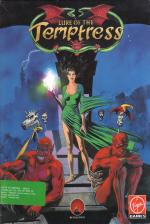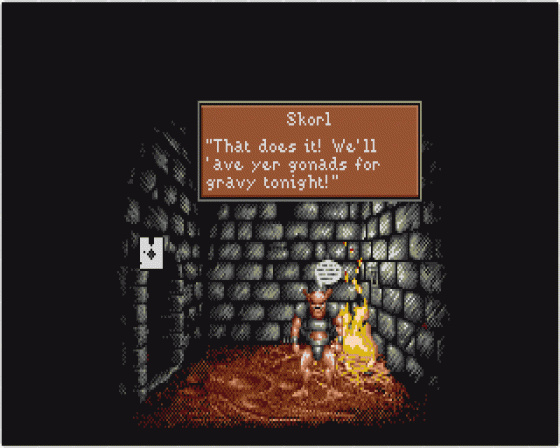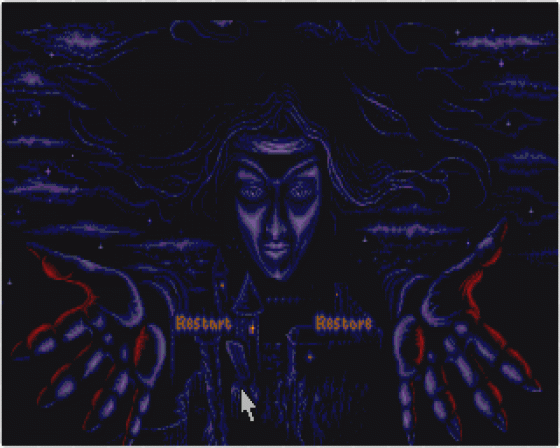
ST Format
 1st July 1992
1st July 1992
Categories: Review: Software
Author: Ed Ricketts
Publisher: Virgin Games
Machine: Atari ST
Published in ST Format #35
Lure Of The Temptress
If the promise of playing Virtual Reality games where you do exciting things like switch lights on and off leaves you just a little cold, why don't you try Virtual Theatre? Join Ed Ricketts as he arrives late, rustles his programme and coughs annoyingly at the back
We are in a quiet country field. A young lad known only as Diermot is making a groat or two being a beater for the visiting King. Suddenly, up rushes a messenger with a message (stop me if it gets too technical) which says that the nearby village of Turndale has been taken over by an evil enchantress called Selena and her hordes of nasty beasties known as Skorl. Ooh.
By a twist of fate crueller than a particularly cruel fate twist, Diermot is caught up in the rush of the King's army as he gallops off to defeat the Skorl. Thus it is that, the next day, he gets to see the King being well and truly stuffed by the Skorl beasties. The town is taken over, Diermot is captured and thrown into a cell.
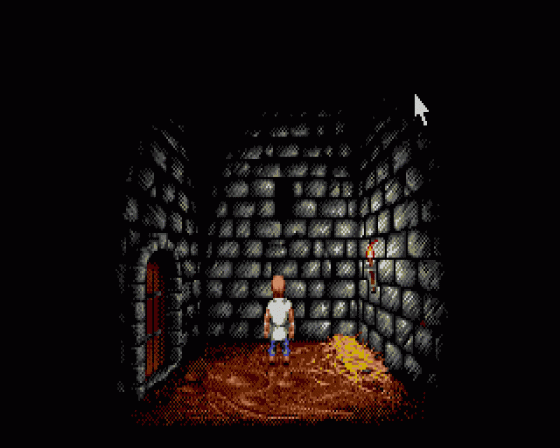
And so we arrive at the beginning of a new RPG. Sorry to sound like a manual there for a moment, but this plot really is quite important to the game. Diermot, a somewhat unwilling hero, has to escape from the dungeon and somehow overthrow the vicious Selena using just his skill, his cunning and his unusual name. Oh, and the help of an amateur jester, Ratpouch, who he rescues early on.
Lure Of The Temptress is the first game to use Revolution Software's new game system, Virtual Theatre. This impressively-named setup is based broadly on the almost textless point 'n click interface of games like The Secret Of Monkey Island, but includes a few significant advances.
You carry out basic actions in the normal way. You walk by clicking where you want to go - the cursor changes to an arrow to indicate possible exits. To manipulate an object, you click on it with the right mouse button, which brings up a list of verbs possible for that object. You then choose one of these verbs possible for that object. You then choose one of these verbs and the command is carried out. Couldn't be simpler.

You talk to other characters - there are a lot of these - in a similar way. After attracting their attention, you're usually presented with a list of questions you can put to them, which changes depending on your current situation. Sometimes only one question is available and this is asked automatically for you.
You can also tell characters to do things for you, although only Ratpouch always obeys you. For instance, you can tell Ratpouch to "Go to Blackfriar's row and then ask monk for knife," and he does it. This is important, because some puzzles can only be solved by making use of other people.
The other main programming advance is autorouting. Instead of having to navigate Diermot around other characters and objects, you simply point him where you want him to go and let him off the leash, as it were. The characters sort themselves out on the screen, politely excusing themselves to other characters and moving out of the way. Oh yes, the other characters talk among themselves too. Sit in the pub and you hear priceless conversations like this one:

Ratpouch to Nellie, the barmaid: You remind me of my mother. Nellie: Oh, really? Ratpouch: Yes, she was a woman, too.
Or Ratpouch might call you over and tell you a joke, like "What do you give a Skorl with diarrhoea?" "Plenty of room." Trust me, these asides are quite funny in the game. So, characters are just as important as objects. Don't insult anyone too much, because they're likely to go off and tell their friends about it, and then they get miffed with you too.
Much of the game takes place in the village of Turndale, though later on there are cave and castle sections (assuming you can work out how to get there). Wherever you are, the graphics are superb: finely detailed, colourful and realistic. The more you play, the more you appreciate the amount of work that's gone into them. Same goes for the sprites - they're a decent size and expertly animated. You can even see the characters' legs moving inside their clothes.
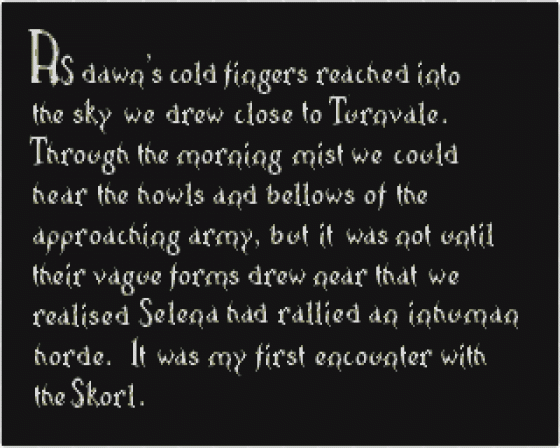
And get this: originally, Revolution were going to use chip noises, but took them out because they weren't good enough. If only, if only, other programmers would think this way. Instead, samples are used at every location, mostly quiet background noises like the dripping of water and the twitter of birds. These samples are so good you don't notice they're there - they become part of the atmosphere.
Verdict
What Revolution Software have come up with is something really rather special, viz. the first serious alternative to Lucasfilm's way of doing things. They've managed to blend a brand new games system with a workable plot, character interaction and stupendous graphics, and then thrown in a huge dollop of humour to lighten things up.
What you shouldn't expect from Lure is another Monkey Island. They are superficially similar, but Lure paints its characters with far more care and realism, and takes its subject matter quite seriously. Although there are points in Lure where you can't progress further without solving a particular problem, it's not nearly as linear as Monkey. Events just don't suddenly happen to move the plot along. Whereas playing Monkey is like watching a film unfold, playing Lure is more like reading a book - events follow a logical course without dramatic scene changes that skip over chunks of time.
Possibly, though, the game is a little easy. It's very difficult to judge a thing like difficulty because often one player spends weeks stuck on a puzzle that another player has zipped past. It's just a feeling that there really isn't enough to do.
As you read this, Revolution are beavering away on the second Virtual Theatre game, this one set in the future. The possibilities offered by this game, written by a team who have used their system thoroughly, are frankly cell-boggling. But don't wait for that - get in on the act now and get yourself a copy of Lure Of The Temptress. It could very well turn out to be the second best thing you do in 1992.
In Brief
- 1MByte only
- Unashamedly based on The Secret Of Monkey Island, it's not quite as manically funny, but its subtleties should stay with you for a long time. You'll be going back and trying things long after you've finished it. And, by God, it's British too.
- Makes Sierra On-Line games look like the graphical, audio and gameplay dinosaurs they always have been.

